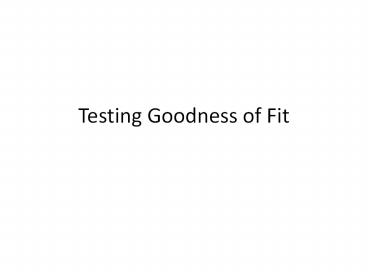Testing Goodness of Fit - PowerPoint PPT Presentation
1 / 11
Title:
Testing Goodness of Fit
Description:
If test statistic falls in main body, Accept Ho. Determine the claim based on ... 19 B s, 11 C s, 2 D s, and 14 F s. Does their distribution differ from the ... – PowerPoint PPT presentation
Number of Views:36
Avg rating:3.0/5.0
Title: Testing Goodness of Fit
1
Testing Goodness of Fit
2
Definitions / Notation
3
Properties of Chi-Square Distribution
- Not symmetric, it is skewed to the right
- Values of the chi-square statistic are always
greater than or equal to 0 (never negative)
4
Finding Chi-Square Statistic
- Determine degrees of freedom (DF n 1)
- Determine the area to the right of the desired
value (may have to divide a into tails in certain
cases, assume right tail only for this topic) - Using DF and Area to the Right, look up the
chi-square statistic in Table A.4 Critical Values
for the ?2 Distribution
5
Expected Frequencies
- If the probabilities specified by Ho are p1, p2,
, and the total number of trials is n, the
expected frequencies are - E1 np1, E2 np2, and so on
6
Hypothesis for Goodness-of-Fit Tests
- The null hypothesis always specifies a
probability for each category. The alternate
hypothesis says that some or all of these
probabilities differ from the true probabilities
of the categories
7
Classical Approach (By Hand)
8
Classical Approach (TI-83/84)
- Write down a shortened version of claim
- Come up with null and alternate hypothesis (Ho
has a probability for each category while H1 says
that some or all of the actual probabilities
differ from those specified in Ho) - See if claim matches Ho or H1
- The picture is always a right tail so put a into
the right tail - Place observed frequencies into L1 and expected
frequencies (np for each category) into L2 - Find critical values (Table A.4 using a and DF
k 1 where k is the number of categories) - Find test statistic (?2GOF-Test)
- If test statistic falls in tail, Reject Ho. If
test statistic falls in main body, Accept Ho.
Determine the claim based on step 3
9
P-Value Approach (TI-84 Plus)
- Write down a shortened version of claim
- Come up with null and alternate hypothesis (Ho
has a probability for each category while H1 says
that some or all of the actual probabilities
differ from those specified in Ho) - See if claim matches Ho or H1
- Find p-value (X2GOF-Test)
- If p-value is less than a, Reject Ho. If p-value
is greater than a, Accept Ho. Determine the
claim based on step 3
10
1. Claim
- Following are observed frequencies. The null
hypothesis is Ho p1 0.25, p2 0.20, p3
0.50, p4 0.05
1 2 3 4
Category 1 2 3 4
Observed 200 150 350 20
11
Check It Out
- In the 1950s-1960s there was a tendency to
grade on a true curve 10 got As, 20 got
Bs, 40 got Cs, 20 were Ds, and 10 were Fs. - Applying this flawed model, an instructor has the
following distribution 94 As, 19 Bs, 11 Cs, 2
Ds, and 14 Fs. Does their distribution differ
from the true curve? Is this instructor
inflating their grades?































